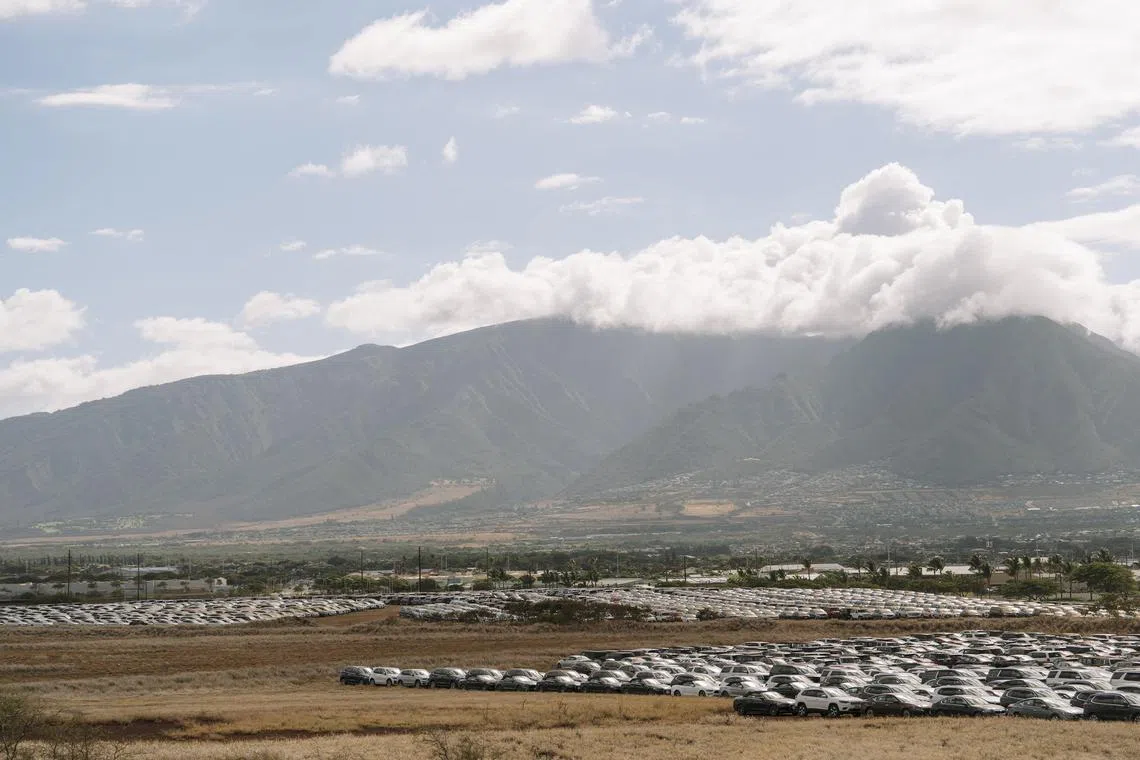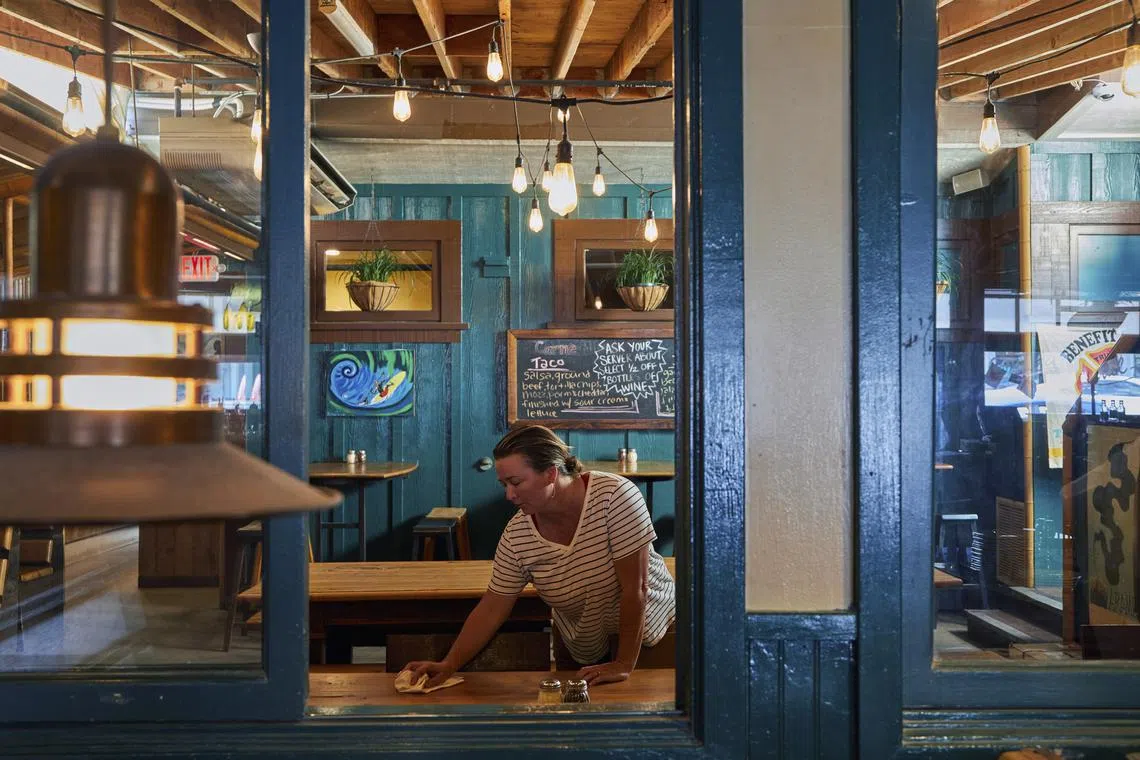Tourists wanted, as message to avoid Maui is rescinded
Sign up now: Get ST's newsletters delivered to your inbox

Nearly a month after the fire, Maui, is hosting fewer visitors than at any point since the Covid-19 pandemic.
PHOTO: NYTIMES
Follow topic:
PAIA, Hawaii – In the first few days after an inferno levelled the Hawaiian town of Lahaina,
As it turns out, maybe too well.
Nearly a month after the fire, Maui, a tourism-dependent island with a hotel room for every 7 1/2 households, is hosting fewer visitors than at any point since the Covid-19 pandemic. Pristine beaches sit empty, even those that are many miles from Lahaina.
Hundreds of unused rental cars are parked in fields near the island’s main airport in Kahului, where planes arrive half full. Beds are made and pillows are fluffed in hotel rooms where no one has laid a head in weeks.
All of it means that the workers who form the backbone of Hawaii’s welcoming aloha spirit are now struggling. In some of Maui’s fanciest resorts, employees are being sent home with no work and no pay.
“Right now, it’s hard to think about the future and if we’re going to make next month’s rent,” said Mr Owen Wegner, a line cook at the Grand Wailea resort in South Maui, some 48km outside the burn zone. He has only been called in to work two shifts in the past two weeks.
Mr Wegner, 20, was born and raised in Lahaina and used to play a snare drum during parades down Front Street, the town’s once-idyllic commercial thoroughfare along the ocean.
The fire on Aug 8 turned the street into a graveyard of charred cars and burned buildings – and became the nation’s deadliest wildfire in a century, claiming at least 115 lives. Among them was Mr Wegner’s grandmother who helped raise him, Ms Lynn Manibog.
Mr Wegner has had almost no time to grieve. Instead, he has been trying to figure out how to provide for his partner Sabrina Kaitlyn Cuadro; their one-year-old son; and their daughter, who is due to be born Sept 5. That is also the last day they can pay their monthly rent before late fees kick in.
“Me and her are under a lot of stress,” Mr Wegner said.
The implosion of Maui’s economy, of which tourism comprises about 40 per cent, has been swift and severe.
State economic officials estimate that the island is seeing about 4,250 fewer visitors each day than normal, representing a loss of US$9 million (S$12.2 million) a day. In South Maui, seven of every 10 hotel rooms sit empty, compared with about two in 10 during normal times.
The plummeting numbers follow contradictory pleas from Hawaii’s politicians and residents.

Hundreds of unused rental cars are parked in fields near the island’s main airport in Kahului, where planes arrive half full.
PHOTO: NYTIMES
The governor and lieutenant governor issued emergency proclamations in the first days after the fire, saying that all non-essential travel to Maui was “strongly discouraged”.
Days later, Governor Josh Green issued a revised order limiting its scope to the region of the fire, West Maui, which makes up only a small portion of the island.
But tourism officials fear that prospective visitors may not be familiar with the island’s geography. Now, many politicians, workers and industry leaders are making a new plea to tourists: come back.
“We stress that West Maui is not currently the place for people to go, but the rest of Maui is open,” Mr Richard Bissen, the Maui County mayor, said this week.
Maui’s residents have remained consistent that visitors should avoid all of West Maui, which continues to be a hub for displaced families.
Hotels there are housing more than 5,000 people who are not tourists, including families who lost homes, government relief officials, aid organisations and clean-up crews.
Locals have also warned people against clogging up the highway in a quest to see the destroyed town of Lahaina. They remind tourists elsewhere on the island to be sensitive to the fact that people they encounter may have lost their own homes or have connections to people who perished.
There has long been tension between Hawaii locals and tourists, and some residents have argued that the sharp drop in revenue Maui now faces is a sign that the state should prioritise residents over tourists and rely on more sustainable industries.

The fire on Aug 8 turned the street into a graveyard of charred cars and burned buildings – and became the nation’s deadliest wildfire in a century.
PHOTO: NYTIMES
Mr Chris West, president of the local International Longshore and Warehouse Union, which also represents workers in the tourism and pineapple industries, said that he and other Native Hawaiians have complicated feelings about tourists but that their return was needed to sustain the economy.
“So visit, but be respectful, and we can coexist,” Mr West said.
In Paia, a colorful town brimming with stores and restaurants on the North Shore, shops are usually hopping, even on a weekday afternoon.
There is typically a long line to order at the Paia Fish Market, a stream of people peering into the window at Mele Ukulele, and tourists finding shade on the front patio of Tobi’s Poke and Shave Ice.
But many of the stores were eerily empty on a recent weekday, and at one local pizzeria, there were so many empty booths that the general manager had plopped himself into one to get some work done. Two men sat alone at the bar.
Ms Annie Mullen, who has worked at the restaurant off and on for the last 12 years, said that business had come nearly to “a full stop” since the fire in Lahaina, about a 45-minute drive away.

Ms Annie Mullen at Flatbread Company, a pizza restaurant in Paia on the Hawaiian island of Maui.
PHOTO: NYTIMES
Ms Mullen said she felt guilty for worrying about her employees’ pay cheques and her own when so many people had died. But she said she feared things would get worse if visitors continued to stay away.
“It’s really hard to navigate the grief and the shock of what horrific event just took place but then also to have to feel selfishly worried about finances at the same time,” she said. NYTIMES

